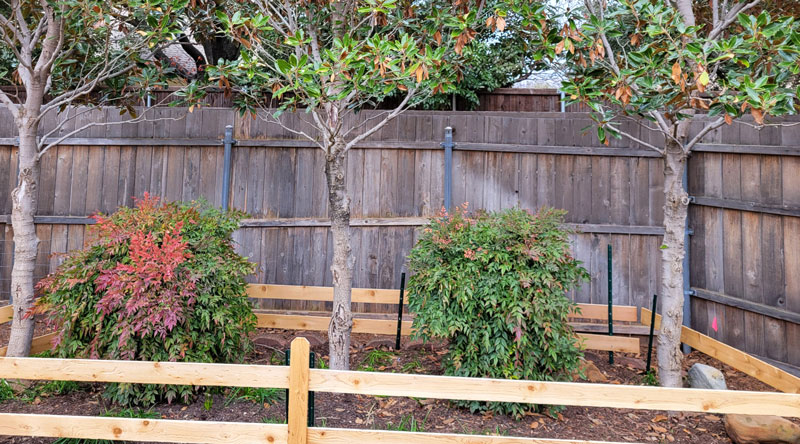Q&A – Ask Neil: March 27, 2025
(Please read these instructions carefully.)
Before you post your question, please look at recent issues to see if someone else has already asked it. You might find your answer there.
How to submit your question…
(Note: You may need to allow a pop-up window to come up in order to get the link for sending your photo(s). If you have already submitted your question and didn’t see the pop-up window, please click here.)
• Click the link provided below to post your question. After you submit your question, a new window will pop up giving you the address to which you can e-mail a SHARP, HIGH-RESOLUTION PHOTO to accompany your question. Please DO NOT SEND THUMBNAIL PHOTOS in case I need to zoom in to see things.
• Click here to post your question.
• Please ONLY POST YOUR QUESTION ONE TIME. We can only accept a set number of questions each week, and when we get duplicates it costs other people their chances.
• One question per reader, please.
• Please use this only for posting questions – not for standard emails.
• Watch for your answer in the following week’s e-gardens.
• I choose those of greatest general interest. For example, plant IDs seldom make the cut.
• I must have your first name or initials.
• I must have your city or county. (Texas is a very large state.)
QUESTION 1
WHERE SHOULD FERTILIZER BE APPLIED TO MATURING EASTERN REDCEDARS?
Question: My 24 eastern redcedar junipers were planted a few years ago. Now the bubbler sprinkler head is really close to the much larger trunk. How do I fertilize/water out at the drip line? Should I fertilize right at the sprinkler head near the trunk? Bill M., Prosper.
Answer: A tree’s most active roots in terms of taking up water and nutrients will be near and just beyond the drip line (the outer canopy of the branches). That’s where you want to apply water and fertilizer. Without a photo I can’t give very good advice, but it sounds like you might need to consider moving the heads out farther. Eventually your trees will probably be able to survive on their own, needing supplemental irrigation in only the dryest of weather. There is little to be gained by putting either water or fertilizer up around the trunks of maturing trees.
QUESTION 2
HOW CAN I KEEP WEEDS OUT OF A YOUNG WINTERCREEPER BED?
Question: I cleaned flowerbeds last year and planted purple wintercreeper euonymus groundcover. It’s doing well, but it still hasn’t covered the area. We constantly have weeds coming up in the beds and overtaking the area. Is there a way to eliminate the weeds? Julie B., Royse City.
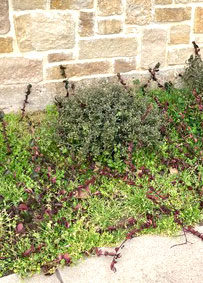
Answer: Here’s the pattern. First year, the wintercreeper grows vigorously (assuming you planted it at proper spacings and kept it properly watered and fed). Second year it covers completely and starts to build up on itself. Third year it forms a 4- to 6-inch-deep groundcover bed that will choke out all but the most aggressive of weeds. During that time your best bet is to hoe or cut out the weeds manually. I can’t see the weeds well enough in your photo to tell what they are, but I assume they are broadleafed, cool-season weeds such as chickweed. They will soon die away with the upcoming heat. Apply Gallery pre-emergent granules to the bed around September 10 to lessen the number of new seedlings you might get next fall and winter.
QUESTION 3
WHAT IS ACTIVATION REQUIREMENT (RAINFALL) FOR PRE-EMERGENT GRANULES?
Question: We seem to talk a lot about application of pre-emergent weedkiller granules in terms of timing for proper month, weeks, timeframe, etc. However, what is the activation requirement for pre-emergents in terms of how much water within how many days of application? MAC, Tarrant County.
Answer: You want to apply whichever pre-emergent herbicide granules you choose, then almost immediately water them into the top inch of soil with what I would call a moderate irrigation. You must not wait for rainfall to do the job for you. There’s probably enough native water in the soil to start dissolving the granules even if you don’t water, so you need to get them soaked in so they can disperse. You certainly don’t want them to get hit by a heavy rain for fear that they could wash away off the surface.
QUESTION 4
HOW CAN WE REDUCE THE AMOUNT OF LAWN WE HAVE TO MOW?
Question: (Lynn C’s question was truncated by our word limit as the size of the second area was being typed. I’ll do the best I can.)
We would like to reduce the amount of lawn we have to mow by converting the back two corners of our property to something lower in maintenance. The areas get full sun but are not irrigated. One corner is 34 x 34 ft. The other is 50 x 50 ft. Lynn C., Harris County.
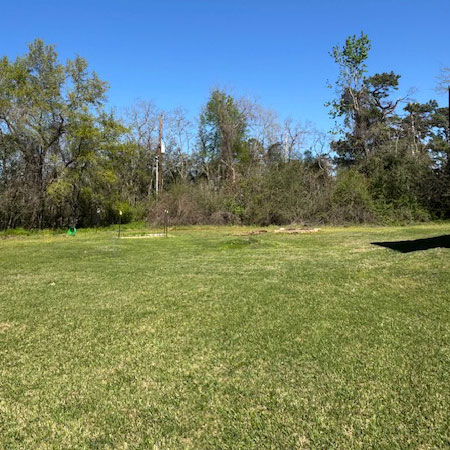
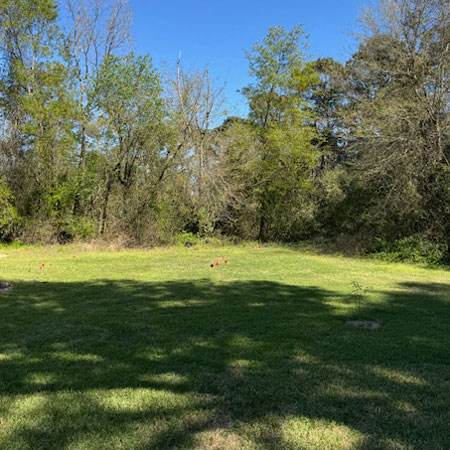
Answer: I would suggest wide, sweeping beds filled with bark mulch to simulate the forest floors you see all around Houston. You could easily enough plant yaupon hollies or other types of hollies for a natural green look all year long – that’s what I’ve done beneath our large pecan trees. I’ve also used mondograss as my groundcover (also known as “monkeygrass”). Granted, those would require irrigation for their first couple of years as they became established, but that wouldn’t be as big an issue in Houston as it might be farther west and northwest.
QUESTION 5
WHAT HAS CAUSED THE BARK OF MY LITTLE GEM MAGNOLIAS TO DECAY? WHAT ARE THE ROWS OF HOLES?
Question: Please help with our 4 Little Gem southern magnolias. All 4 have areas where the bark has decayed. They also have rows of holes 5-6 ft. up from the ground. What caused those? Meg R., Allen.

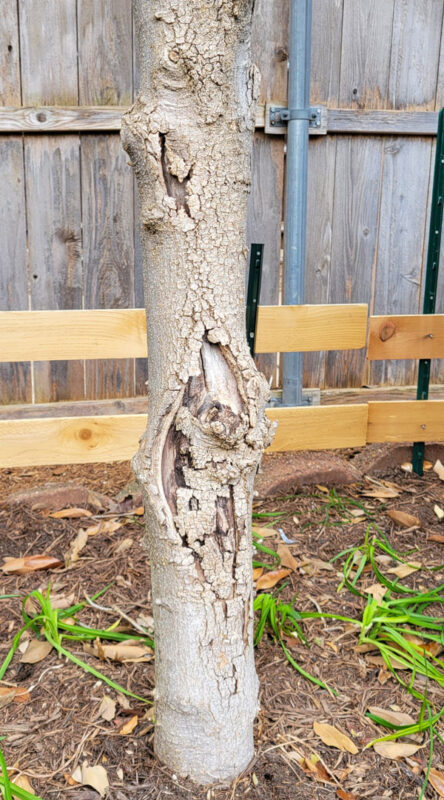
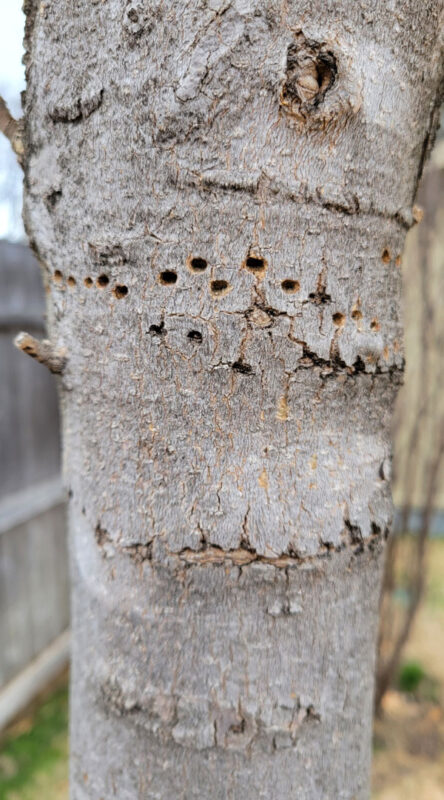
Answer: I’ll start with the rows of holes. They’re caused by woodpeckers or sapsuckers. They’re common on pecans, oaks, and several other species of trees, although I’ve never seen them do measurable damage to magnolias. They often come back and feed on the sap that exudes from the holes they leave behind. That sap may also have given rise to the black sooty mold I can see farther up on one of the trunks.
As for the cracks, that’s a bit more puzzling. If they are all on the west or southwest sides of the trunks, that would be sunscald. That’s common on red maples, Chinese pistachios, red oaks, and a few other tree species. I haven’t seen it so much on southern magnolias. The sun hits the west sides of trunks and causes them to overheat. The bark deteriorates, and after a couple of years it starts to flake off leaving the internal wood exposed to the elements. It appears that the trunk in the closeup has significant damage. A good bit more bark is apparently going to be lost. I also note that the root flare may be below grade, so that may be a factor – the trees may have been planted too deeply. You probably need to have a certified arborist on site to examine the bark loss more closely.
Your trees look like they need nitrogen and water. I’d apply both and see how they respond.
QUESTION 6
WHAT ARE THESE GROWTHS ON MY SHUMARD RED OAKS?
Question: These tennis ball-sized growths on my Shumard red oak look like large wasp galls, but they’re hard as a rock and don’t seem to be interfering with new leaf growth. Is there any call to action? I’m not up to climbing 30 ft. in the air. Jim B., Missouri City.
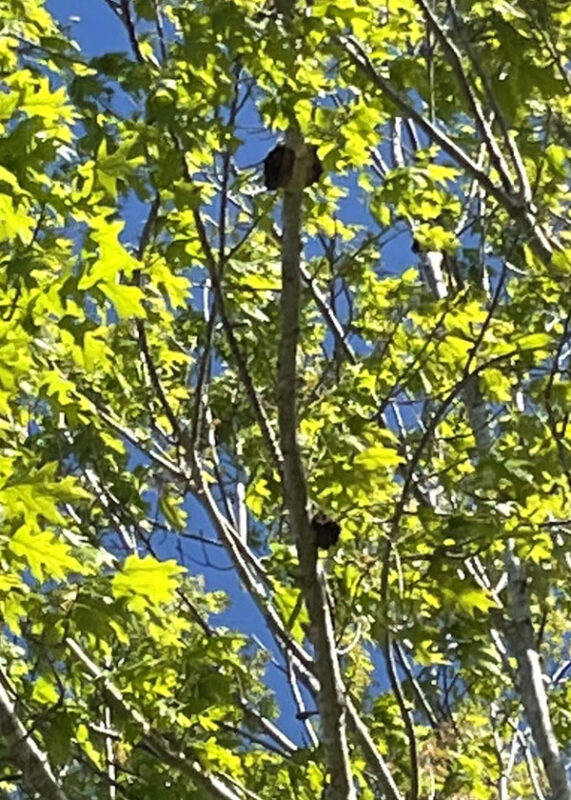
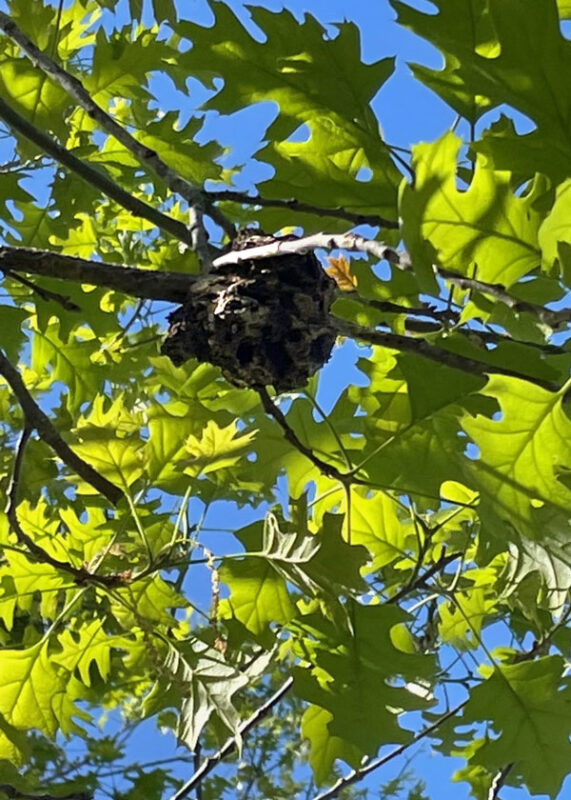
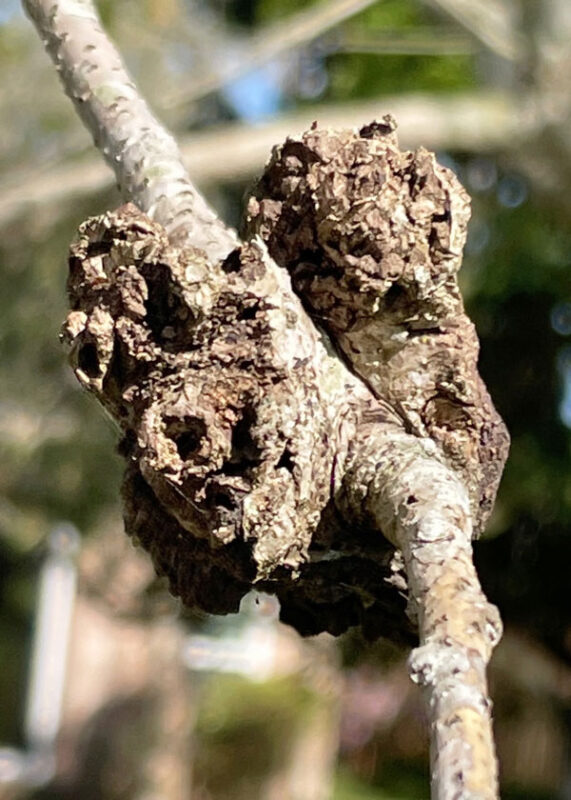
Answer: To the best of my ability and with the help of a veteran certified arborist who was away from his office as he replied to me, this appears to be gouty, or knotty oak gall caused by a small wasp. I’ll let you read this information from the University of Delaware. It was the most detailed I found in my time spent searching online. I note that most sites say there is limited chance of controlling it other than to prune out the developing galls before they mature so that you can get rid of the immature wasp larvae that are living inside. It wouldn’t hurt to have a certified arborist in your area watch the tree a couple of times a year for a few years while you also do your own homework online to see if any other suggestions pop up. I would always include the words “university” and “entomology” in your searches to get to the real pros along with the key words “gouty oak gall Shumard red oak.”

